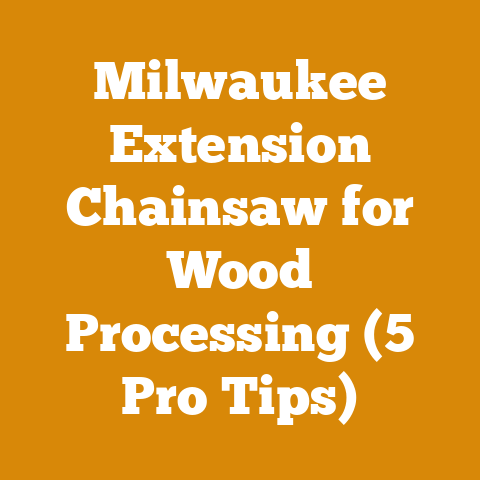Outdoor Wood Burning Forced Air Furnace (5 Pro Tips for Efficiency)
Outdoor Wood Burning Forced Air Furnace: 5 Pro Tips for Efficiency
As someone who’s spent a good chunk of my life wrestling with logs and coaxing warmth from wood, I understand the allure of an outdoor wood-burning forced-air furnace. There’s a certain self-sufficiency, a connection to nature, and a satisfying feeling of independence that comes from heating your home with wood you’ve prepared yourself. But let’s be honest, it can also be a demanding and sometimes inefficient process.
I know that the needs of someone heating a small cabin in the Adirondacks are very different from someone trying to warm a sprawling farmhouse in the Midwest. That’s why I’ve put together these five pro tips to help you maximize the efficiency of your outdoor wood furnace, no matter your climate or specific situation. These aren’t just theoretical ideas; they’re based on years of practical experience, a few hard lessons learned, and a commitment to getting the most heat for my buck (and back).
1. Master the Art of Wood Selection and Seasoning: The Foundation of Efficiency
Let’s face it, burning wet wood is like trying to start a campfire with a sponge. It’s frustrating, smoky, and produces minimal heat. The type of wood you burn and how well it’s seasoned are, without a doubt, the most critical factors influencing the efficiency of your outdoor wood furnace.
Understanding BTU Content:
Different wood species have vastly different BTU (British Thermal Unit) content, which is a measure of the amount of heat released when burned. Hardwoods generally pack a bigger punch than softwoods. Here’s a quick rundown of some common firewood species and their approximate BTU values per cord (air-dried):
- Oak (Red/White): 24-27 million BTU
- Hickory: 25-28 million BTU
- Maple (Sugar/Red): 20-24 million BTU
- Beech: 20-22 million BTU
- Ash: 20-24 million BTU
- Birch: 20 million BTU
- Pine: 15-18 million BTU
- Poplar: 12-14 million BTU
Personal Story: I learned this lesson the hard way. One year, I was short on seasoned oak and decided to supplement with a significant amount of poplar, thinking it would be “good enough.” My furnace ran constantly, the house was barely warm, and I burned through wood at an alarming rate. It was a costly and uncomfortable mistake that reinforced the importance of using high-BTU, well-seasoned wood.
The Seasoning Process: Patience is Key:
Seasoning wood is the process of reducing its moisture content to an acceptable level for burning. Ideally, you want firewood with a moisture content below 20%. Burning wood with higher moisture content wastes energy, creates more smoke, and can lead to creosote buildup in your chimney, increasing the risk of a chimney fire.
- How to Season: Split the wood, stack it loosely in a sunny, well-ventilated area, and cover the top to protect it from rain and snow.
- Seasoning Time: Hardwoods typically require 6-12 months of seasoning, while softwoods can be ready in 3-6 months.
- Testing Moisture Content: Invest in a moisture meter. They’re relatively inexpensive and will give you a reliable reading of your wood’s moisture content. Aim for readings below 20%.
- Pro Tip: I often mark the date I split and stack each pile of wood. This helps me keep track of what’s ready to burn and avoid accidentally burning green wood.
Data-Backed Insight: A study by the Biomass Energy Resource Center found that burning seasoned wood can improve heating efficiency by up to 30% compared to burning green wood.
Actionable Takeaway: Prioritize obtaining and seasoning high-BTU hardwoods. Start the seasoning process well in advance of the heating season. Use a moisture meter to ensure your wood is properly seasoned before burning.
2. Optimize Your Wood Processing Techniques: From Forest to Furnace
How you process your wood has a significant impact on how efficiently it burns. Proper splitting, cutting, and stacking all contribute to a hotter, cleaner, and more efficient burn.
Splitting for Efficiency:
- Why Split? Splitting wood increases its surface area, allowing it to dry faster and burn more readily.
- Splitting Technique: Aim for pieces that are approximately 4-6 inches in diameter. Larger pieces may not dry properly, while smaller pieces may burn too quickly.
- Tools of the Trade: A good splitting axe is essential. I prefer a maul for larger rounds and a smaller splitting axe for smaller pieces. Consider a hydraulic log splitter if you process a large volume of wood.
- Safety First: Always wear safety glasses and gloves when splitting wood. Position yourself on a stable surface and be mindful of your surroundings.
Cutting for Optimal Size:
- Matching Wood Length to Your Furnace: The length of the wood you cut should be appropriate for the size of your firebox. Refer to your furnace manufacturer’s recommendations.
- Consistent Lengths: Cutting wood to consistent lengths makes stacking easier and ensures a more even burn.
- The Chainsaw Conundrum: While chainsaws are invaluable for felling trees and bucking logs, they can also be dangerous. Always wear appropriate safety gear (helmet, eye protection, hearing protection, chaps) and follow safe operating procedures.
- Chainsaw Maintenance: A sharp chain is essential for efficient and safe cutting. Learn how to sharpen your chain or have it professionally sharpened regularly.
Stacking for Airflow:
- Loose Stacking: Stack your wood loosely to allow for maximum airflow. This will help it dry faster and more evenly.
- Elevated Stacking: Stack your wood on pallets or other elevated surfaces to prevent it from absorbing moisture from the ground.
- Covering the Top: Cover the top of your woodpile with a tarp or other waterproof material to protect it from rain and snow. Leave the sides open to allow for ventilation.
- Stacking Method: I personally prefer the “holzhaufen” method, a circular stack that promotes excellent airflow and stability. It’s a bit more work to build initially, but the benefits are well worth it.
Real Example: I once worked with a small logging operation in Vermont that was struggling to meet their firewood production goals. By implementing stricter quality control measures, focusing on proper splitting techniques, and improving their stacking methods, they were able to increase their production by 20% and reduce their drying time by almost a month.
Actionable Takeaway: Invest in quality splitting tools. Cut your wood to the appropriate length for your furnace. Stack your wood loosely and cover the top to protect it from the elements.
3. Mastering Airflow and Combustion: The Heart of Efficient Burning
The efficiency of your outdoor wood furnace hinges on achieving optimal combustion. This means providing the right amount of air at the right time to ensure that the wood burns completely and cleanly.
Understanding Combustion Stages:
- Primary Combustion: This is the initial stage where the wood is heated and releases volatile gases.
- Secondary Combustion: This is where the volatile gases are burned, producing the majority of the heat.
- Tertiary Combustion: In some advanced furnaces, a third stage of combustion is used to further reduce emissions and extract more heat.
Airflow Control:
- Dampers and Air Intakes: Your furnace will have dampers and air intakes that allow you to control the amount of air entering the firebox.
- Finding the Sweet Spot: Experiment with different damper settings to find the optimal balance between airflow and burn rate. Too much air will cause the wood to burn too quickly, while too little air will result in incomplete combustion and excessive smoke.
- Observation is Key: Pay attention to the color of the flames and the amount of smoke coming from the chimney. A clean, hot burn will have bright yellow flames and minimal smoke. A smoky burn indicates incomplete combustion.
Loading Techniques:
- Top-Down Burning: Some newer furnaces are designed for top-down burning, where the fire is started at the top of the woodpile and burns downward. This method promotes cleaner and more efficient combustion.
- Crib Loading: Another effective technique is to load the wood in a “crib” configuration, with the pieces arranged in a crisscross pattern. This allows for good airflow and even burning.
- Avoid Overloading: Don’t overload the firebox. This can restrict airflow and lead to incomplete combustion.
Data Point: According to the EPA, properly designed and operated wood-burning appliances can reduce particulate matter emissions by up to 70% compared to older, less efficient models.
My Experience: I’ve found that learning to “read” the fire is crucial. By observing the flames, the smoke, and the overall performance of the furnace, I can fine-tune the airflow and loading techniques to achieve optimal efficiency. It’s a skill that takes time and practice to develop, but it’s well worth the effort.
Actionable Takeaway: Familiarize yourself with the airflow controls on your furnace. Experiment with different loading techniques to find what works best for your setup. Observe the fire and adjust the airflow accordingly.
4. Regular Maintenance and Cleaning: Ensuring Long-Term Performance
Just like any other piece of equipment, your outdoor wood furnace requires regular maintenance and cleaning to ensure optimal performance and longevity. Neglecting maintenance can lead to reduced efficiency, increased emissions, and even safety hazards.
Chimney Cleaning:
- Creosote Buildup: Creosote is a flammable substance that accumulates in the chimney as a result of incomplete combustion.
- Frequency of Cleaning: The frequency of chimney cleaning depends on the type of wood you burn, the efficiency of your furnace, and the amount of wood you burn. Generally, it’s recommended to have your chimney inspected and cleaned at least once a year, or more frequently if you burn a lot of wood.
- DIY vs. Professional: You can clean your chimney yourself using a chimney sweep brush, but it’s often best to hire a professional chimney sweep. They have the tools and expertise to thoroughly clean your chimney and identify any potential problems.
- Safety Note: A chimney fire can be extremely dangerous. If you suspect you have a chimney fire, call the fire department immediately.
Firebox Cleaning:
- Ash Removal: Regularly remove ash from the firebox. Excessive ash buildup can restrict airflow and reduce combustion efficiency.
- Cleaning the Heat Exchanger: The heat exchanger is the part of the furnace that transfers heat to the water or air that circulates through your home. Clean the heat exchanger regularly to remove any soot or ash buildup.
- Inspecting for Damage: While cleaning the firebox, inspect for any signs of damage, such as cracks or corrosion. Repair any damage promptly to prevent further deterioration.
Water Treatment (if applicable):
- Corrosion Prevention: If your furnace uses water as a heat transfer medium, it’s important to treat the water to prevent corrosion and scale buildup.
- Water Testing: Have your water tested regularly and add appropriate chemicals to maintain the proper pH balance.
- Following Manufacturer’s Recommendations: Follow the manufacturer’s recommendations for water treatment.
Case Study: A homeowner in Maine experienced a significant drop in the efficiency of their outdoor wood furnace. Upon inspection, it was discovered that the chimney was heavily coated with creosote and the heat exchanger was clogged with soot. After cleaning the chimney and heat exchanger, the furnace’s efficiency was restored to its original level.
Personal Touch: I make it a habit to thoroughly inspect my furnace at the end of each heating season. This allows me to identify any potential problems and address them before the next winter rolls around. It’s a small investment of time that can save you a lot of headaches (and money) in the long run.
Actionable Takeaway: Schedule regular chimney inspections and cleaning. Remove ash from the firebox regularly. Clean the heat exchanger and inspect for damage. Treat the water (if applicable) to prevent corrosion.
5. Insulation and Heat Distribution: Maximizing the Warmth in Your Home
Even the most efficient outdoor wood furnace won’t do much good if your home is poorly insulated or if the heat isn’t distributed effectively. Improving insulation and optimizing heat distribution are essential for maximizing the overall efficiency of your wood-burning heating system.
Insulation is Key:
- Attic Insulation: Ensure that your attic is adequately insulated. Heat rises, so a well-insulated attic will prevent heat from escaping through the roof.
- Wall Insulation: Insulate your walls to reduce heat loss.
- Window and Door Sealing: Seal any cracks or gaps around windows and doors to prevent drafts.
- Professional Energy Audit: Consider having a professional energy audit performed to identify areas where your home is losing heat.
Heat Distribution Strategies:
- Forced-Air Systems: Ensure that your ductwork is properly sealed and insulated to prevent heat loss. Consider installing a programmable thermostat to optimize heating schedules.
- Hydronic Systems: Balance the flow of water to each radiator or baseboard heater to ensure even heat distribution. Consider installing thermostatic radiator valves to control the temperature in individual rooms.
- Circulation Pumps: Make sure your circulation pumps are working properly to circulate the heated water efficiently.
- Fans: Strategically placed fans can help circulate warm air throughout your home.
Data Insight: The U.S. Department of Energy estimates that homeowners can save up to 20% on their heating bills by properly insulating their homes and sealing air leaks.
My Recommendation: I’ve found that a combination of good insulation and strategic fan placement is the most effective way to distribute heat evenly throughout my home. I also use a programmable thermostat to automatically adjust the temperature based on my schedule.
Actionable Takeaway: Improve your home’s insulation. Seal air leaks around windows and doors. Optimize your heat distribution system. Use fans to circulate warm air.
By implementing these five pro tips, you can significantly improve the efficiency of your outdoor wood-burning forced-air furnace and enjoy a warm, comfortable home all winter long. Remember, wood heating is a blend of art and science. It takes time, patience, and a willingness to learn and adapt. But with a little effort, you can harness the power of wood to heat your home efficiently and sustainably. And nothing beats the satisfaction of knowing you’ve earned your warmth by your own hard work. Now, go get splitting!






